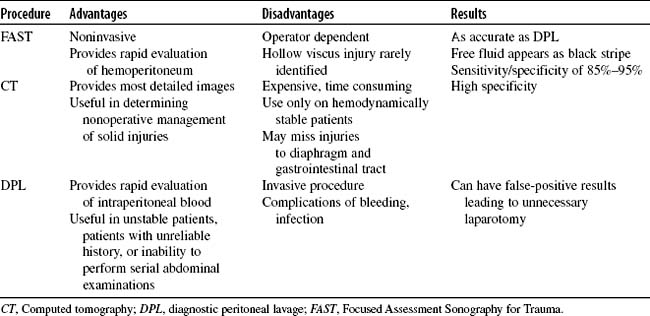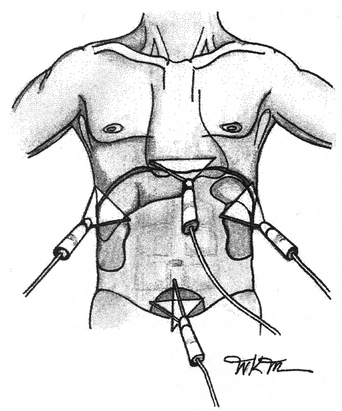CHAPTER 32 Abdominal and Urologic Trauma
I. GENERAL STRATEGY
A. Assessment
1. Primary and secondary assessment/resuscitation (see Chapters 1 and 31)
3) Liver function tests (aspartate aminotransaminase [AST], alanine aminotransferase [ALT], lactate dehydrogenase [LDH], alkaline phosphatase)
3) Focused Assessment Sonography for Trauma (FAST) (Table 32-1)
4) Diagnostic peritoneal lavage (DPL) (see Table 32-1)
b) Following decompression of the bladder and the stomach, a peritoneal catheter is inserted into the abdomen below the umbilicus
d) If gross blood is not noted, 1 L of isotonic crystalloid solution is infused through the catheter. The lavage fluid is then allowed to passively drain back out by gravity and is sent to the laboratory for analysis
C. Planning and Implementation/Interventions
F. Age-Related Considerations
1) Because of greater fluid needs related to body surface area, fluid, fluid/electrolyte, and acid-base balance are more precarious
3) Children can compensate for a 25% blood loss by increasing their heart rate and peripheral vascular resistance, thereby maintaining normal systolic blood pressure. Blood pressure is an unreliable early indicator of shock in children
4) The abdominal muscles are thinner, weaker, and less developed. The liver is more easily injured because it lies anteriorly and is less protected by the ribs. The kidneys are mobile and are not protected by fat
2) The older adult has a decreased ability to adjust to extremes of temperature; care should be taken to minimize body exposure and maintain normothermia
3) Peristalsis and gastric motility slow with aging. Older adults often have preexisting malnutrition and anemia
2) Urine output may not be a reliable indicator of overall tissue perfusion because the older adult has a decreased ability to concentrate urine
II. SPECIFIC ABDOMINAL INJURIES
A. Liver
2. Analysis: differential nursing diagnoses/collaborative problems
3. Planning and implementation/interventions
5) Assist with collection and maintenance of physical and forensic evidence as indicated (see Chapter 43)
6) Assist with hospital admission, preparation for the operating suite, or transfer to an institution providing a higher level of care
4. Evaluation and ongoing monitoring (see Appendix B)
B. Spleen





